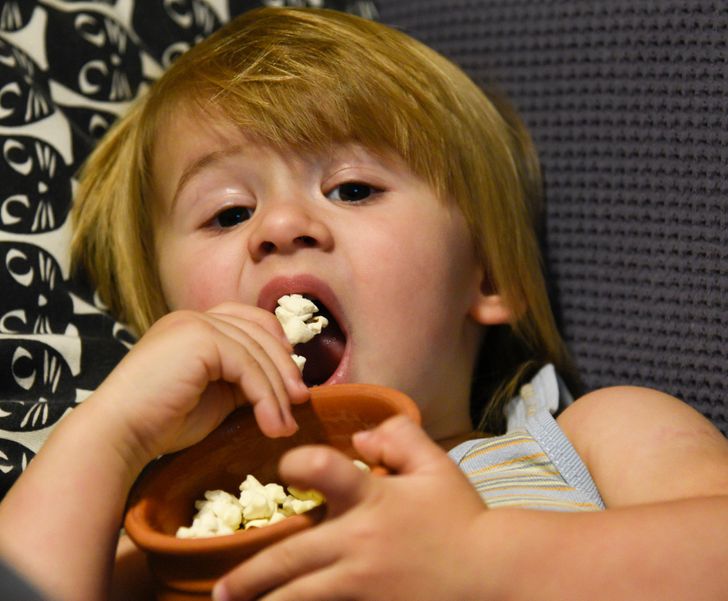Yes, toddlers can eat popcorn, but is popcorn safe for toddlers? The answer is complicated and requires careful consideration. When can toddlers eat popcorn safely? Most experts recommend waiting until at least age 4 to introduce popcorn for toddlers due to the popcorn choking hazard toddler. This comprehensive guide will delve into the potential toddler eating popcorn dangers, provide crucial safety tips, and offer some toddler popcorn alternatives to keep your little one safe and happy.

Image Source: wl-brightside.cf.tsp.li
The Popcorn Peril: Why It’s a Choking Hazard
Popcorn presents a significant choking risk to young children. The shape and texture of popcorn kernels, both popped and unpopped, make them easily lodged in a toddler’s airway. Their swallowing reflexes and chewing skills are still developing, which increases the danger.
Why Popcorn is Risky
Here’s a closer look at why popcorn can be a problem for toddlers:
- Size and Shape: Popcorn kernels are small and irregularly shaped. They can easily conform to the shape of a toddler’s throat.
- Texture: Popcorn hulls are difficult to chew completely and can stick to the throat. Unpopped kernels are even harder and pose a more serious risk.
- Developing Skills: Toddlers haven’t fully mastered chewing and swallowing. They may inhale pieces of food accidentally while eating.
- Small Airways: Toddlers have smaller airways than adults, making them more susceptible to blockages.
The Numbers Speak: Choking Statistics
Choking is a leading cause of injury and death in young children. Food is a common culprit, and popcorn often lands on the list of offenders.
While specific statistics on popcorn-related choking incidents are difficult to isolate, the general data on food-related choking is alarming:
- Choking is a leading cause of nonfatal injuries among children.
- Young children are at a much higher risk of choking compared to older children and adults.
Toddler Popcorn Age: Determining the Right Time
The recommended toddler popcorn age is generally around 4 years old. This age is based on the average development of chewing and swallowing abilities. However, every child develops at their own pace, so it’s important to assess your child’s individual readiness.
Readiness Checklist
Before introducing popcorn, consider the following:
- Chewing Skills: Can your child effectively chew other foods with varying textures?
- Swallowing Coordination: Does your child swallow food safely without frequently coughing or gagging?
- Following Instructions: Can your child understand and follow simple instructions, such as chewing thoroughly?
- Molars: Have most of your child’s molars come in? Molars are essential for grinding food.
If you answer “no” to any of these questions, it’s best to wait longer before introducing popcorn.
Consulting Your Pediatrician
The best course of action is to discuss your concerns with your pediatrician. They can evaluate your child’s development and provide personalized recommendations on when can toddlers eat popcorn safely.
Popcorn Serving Size Toddler: If You Choose to Offer It
Even if your child is over 4 and demonstrates the necessary skills, moderation is key. Start with a small popcorn serving size toddler to gauge their reaction and ensure they can handle it safely.
Recommended Serving Sizes
- Initial Introduction: A few pieces of popcorn to observe how your child manages it.
- Once Tolerated: No more than 1-2 cups of popped popcorn at a time.
Always supervise your child closely while they are eating popcorn.
Preparing Popcorn Safely
How you prepare popcorn can also affect its safety.
- Thoroughly Pop: Ensure all kernels are fully popped.
- Remove Unpopped Kernels: Carefully pick out any unpopped kernels before serving. These are a major choking hazard.
- Avoid Small, Broken Pieces: Discard very small or broken pieces of popcorn.
Best Popcorn for Toddlers: Making Smart Choices
Not all popcorn is created equal. Some varieties are better suited for toddlers than others. Think about selecting the best popcorn for toddlers to minimize any risk.
Types of Popcorn
| Type of Popcorn | Description | Suitability for Toddlers |
|---|---|---|
| Butterfly/Snowflake | Large, irregular shape with “wings.” This is the most common type. | Less ideal due to shape. |
| Mushroom | Round, compact shape. More durable and less likely to break into small pieces. | Better choice. |
| Hull-less | Advertised as having fewer hulls. May be slightly easier to chew. | Slightly better, but still requires caution. |
Avoiding Additives
- Salt and Butter: Limit the amount of salt and butter added to popcorn. Excessive sodium is not healthy for toddlers.
- Artificial Flavors and Colors: Avoid popcorn with artificial flavors, colors, and preservatives.
- Caramel and Candy Coatings: These types of popcorn are high in sugar and can be difficult to chew.
Consider air-popped popcorn with no added salt, butter, or sugar as the safest option.
Toddler Eating Popcorn Dangers: Recognizing the Risks
Even with precautions, it’s important to be aware of the toddler eating popcorn dangers and know what to do in case of an emergency.
Signs of Choking
- Sudden inability to cough, speak, or breathe.
- Gagging or wheezing.
- Bluish skin color (cyanosis).
- Panic or distress.
What to Do If Your Child Is Choking
- Stay Calm: Panic will only make the situation worse.
- Assess the Situation: Determine if your child can cough forcefully. If so, encourage them to keep coughing.
- Back Blows: If your child cannot cough, deliver five firm back blows between their shoulder blades.
- Abdominal Thrusts (Heimlich Maneuver): If back blows are ineffective, perform abdominal thrusts. Place your fist just above your child’s navel, grasp your fist with your other hand, and give five quick upward thrusts.
- Call for Help: If your child is still choking after back blows and abdominal thrusts, call emergency services immediately.
- CPR: If your child becomes unresponsive, begin CPR.
It’s crucial to take a CPR and first aid course to learn how to respond effectively in a choking emergency.
Toddler Snack Ideas Popcorn Alternatives: Safe and Nutritious Options
While popcorn can be a fun snack, there are plenty of safer and more nutritious toddler snack ideas popcorn alternatives.
Healthy and Safe Snack Options
- Soft Fruits: Bananas, blueberries, soft peaches (cut into small pieces).
- Cooked Vegetables: Steamed carrots, peas, sweet potatoes (soft and cut into small pieces).
- Dairy: Yogurt, cheese (cut into small cubes).
- Grains: Soft-cooked pasta, whole-grain crackers (ensure they are easy to chew and swallow).
- Protein: Scrambled eggs, shredded chicken.
Presentation Matters
- Cut Food into Small Pieces: Always cut food into bite-sized pieces that are easy for toddlers to manage.
- Avoid Round, Firm Foods: Grapes, hot dogs, and cherry tomatoes are also common choking hazards and should be avoided or cut into very small pieces.
- Supervise Meal Times: Never leave a toddler unattended while they are eating.
Fathoming The Verdict: Proceed with Caution
While popcorn can be a tasty treat, it’s important to approach it with caution when it comes to toddlers. The risk of choking is real, and it’s best to err on the side of safety. By following these guidelines and consulting with your pediatrician, you can make an informed decision about when and how to introduce popcorn to your child’s diet. Remember, there are many other healthy and safe snack options available for toddlers that can provide the nutrients they need without the choking hazard.
Frequently Asked Questions (FAQ)
-
My toddler ate a few pieces of popcorn. Should I be worried?
If your toddler ate a small amount of popcorn and is not exhibiting any signs of choking, such as coughing, gagging, or difficulty breathing, they are likely fine. However, it’s essential to monitor them closely for the next hour or two to ensure no delayed symptoms develop. If you have any concerns, contact your pediatrician.
-
Can I give my toddler popcorn if I cut it into smaller pieces?
Even if you cut popcorn into smaller pieces, the risk of choking is still present. The irregular shape and texture of popcorn make it difficult for toddlers to chew and swallow safely. It’s generally best to wait until your child is at least 4 years old and has developed adequate chewing and swallowing skills.
-
Is hull-less popcorn safer for toddlers?
While hull-less popcorn may have fewer hulls, it still poses a choking risk to toddlers due to its size and shape. It’s not significantly safer than regular popcorn and should be avoided until your child is old enough to handle it safely.
-
What are some healthy snack alternatives to popcorn for toddlers?
There are many healthy and safe snack alternatives to popcorn for toddlers, including soft fruits (bananas, blueberries), cooked vegetables (steamed carrots, peas), dairy (yogurt, cheese), grains (soft-cooked pasta, whole-grain crackers), and protein (scrambled eggs, shredded chicken). Always cut food into small, bite-sized pieces.
-
My older child is eating popcorn. Can my toddler be in the same room?
Yes, your toddler can be in the same room while your older child is eating popcorn, but it’s crucial to supervise them closely. Ensure that your toddler doesn’t have access to the popcorn and isn’t tempted to grab any pieces. Remind your older child to be mindful of their younger sibling and avoid offering them popcorn.
-
What should I do if my child starts choking on popcorn?
If your child starts choking on popcorn, stay calm and assess the situation. If they can cough forcefully, encourage them to keep coughing. If they cannot cough, deliver five firm back blows between their shoulder blades. If back blows are ineffective, perform abdominal thrusts (Heimlich maneuver). If your child is still choking after these measures, call emergency services immediately and begin CPR if they become unresponsive.
-
Are there any specific popcorn brands that are safer for toddlers?
No specific popcorn brand is inherently safer for toddlers. The key is to choose popcorn with minimal additives (salt, butter, artificial flavors) and ensure that all kernels are fully popped and unpopped kernels are removed. However, even with these precautions, popcorn remains a choking hazard for young children and should be avoided until they are old enough.

Clark Lubowitz is a parenting expert with over 10 years of experience in toddler care and child development. Holding a degree in Early Childhood Education, he specializes in blending modern technology with parenting, offering expert advice on the best toddler gadgets. Through his work on ToddlerAwesome.com, Clark provides valuable insights to help parents make informed decisions for their little ones.
